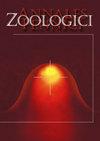Estimating Population Density of the White-Tailed Deer in Finland using Non-Invasive Genetic Sampling and Spatial Capture–Recapture
IF 0.9
4区 生物学
Q4 ECOLOGY
引用次数: 4
Abstract
The white-tailed deer is an important game species in Finland. We evaluated the potential of estimating the white-tailed deer pre-harvest density using non-invasive DNA collection within a spatial capture–recapture (SCR) framework. We sampled faeces during three weekly visits in autumn 2015 from 180, 20 × 20 m plots clustered in groups of four. Individual identification was based on 12–14 microsatellites. Of the 245 faecal samples collected, an individual could be identified from only 36 (15%). We identified 27 white-tailed deer individuals of which seven were recaptured. The SCR model produced a plausible density estimate (3.5 indiv. km–2) which was similar to estimates based on dung count and large-scale national estimates, although a posteriori simulation showed the SCR estimate was likely positive biased. Although we found that SCR based on faecal DNA can provide pre-harvest density estimates of the white-tailed deer, the approach is not without challenges and we discuss these suggesting possible solutions.利用非侵入性遗传采样和空间捕获-再捕获估算芬兰白尾鹿种群密度
白尾鹿是芬兰重要的狩猎物种。我们评估了在空间捕获-再捕获(SCR)框架下使用非侵入性DNA采集来估计白尾鹿采前密度的潜力。我们于2015年秋季进行了三次每周一次的访问,收集了180,20 × 20 m的样地,每组4个。个体识别是基于12-14颗微卫星。在收集到的245份粪便样本中,只有36份(15%)可以识别出个体。我们发现了27只白尾鹿,其中7只被重新捕获。SCR模型得出了一个可信的密度估计(3.5个个体)。km-2),这与基于粪便计数和大规模国家估计数的估计数相似,尽管事后模拟显示SCR估计数可能存在正偏倚。虽然我们发现基于粪便DNA的SCR可以提供采集前白尾鹿的密度估计,但这种方法并非没有挑战,我们讨论了这些可能的解决方案。
本文章由计算机程序翻译,如有差异,请以英文原文为准。
求助全文
约1分钟内获得全文
求助全文
来源期刊

Annales Zoologici Fennici
生物-动物学
CiteScore
2.40
自引率
14.30%
发文量
10
审稿时长
>12 weeks
期刊介绍:
Annales Zoologici Fennici publishes mainly original research reports, but also in-depth reviews and commentaries on all aspects of animal ecology and evolution, and fields related to them. Our aim is to promote papers which focus on the interactions among various components in the past and present environments by using integrative and cross-disciplinary approaches. This may be achieved by employing tools from different fields of research, such as (but not restricted to):
ecology and paleoecology,
molecular ecology and phylogeography,
conservation biology, human-induced contemporary evolution and wildlife management,
animal behaviour and interactions (including recognition systems and mechanisms),
paleontology (except systematics and taxonomy) and evolution,
bioenergetics.
 求助内容:
求助内容: 应助结果提醒方式:
应助结果提醒方式:


